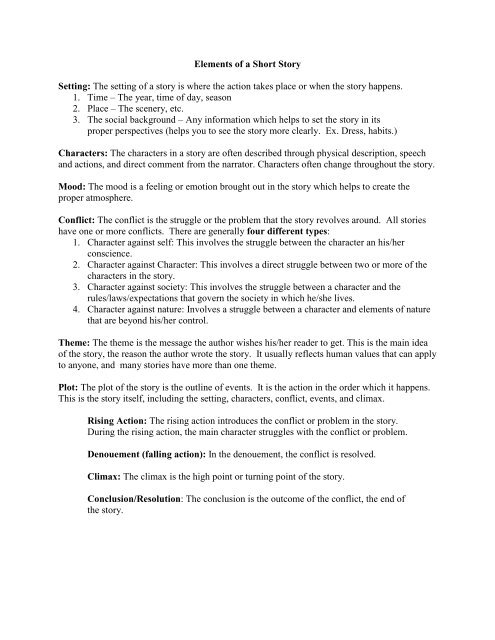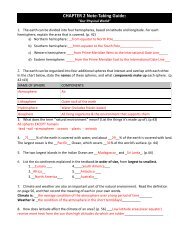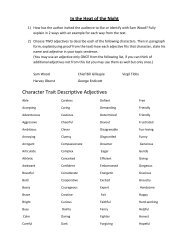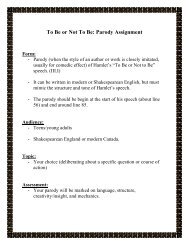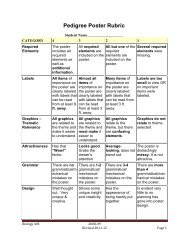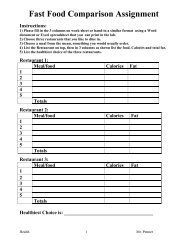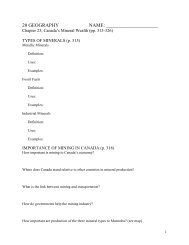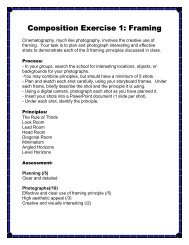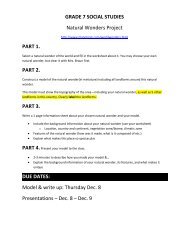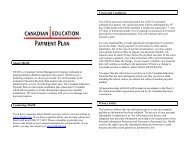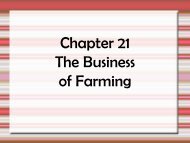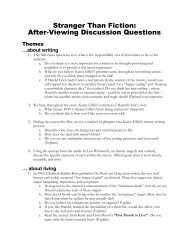Elements of a Short Story (Teacher Copy) - schs
Elements of a Short Story (Teacher Copy) - schs
Elements of a Short Story (Teacher Copy) - schs
You also want an ePaper? Increase the reach of your titles
YUMPU automatically turns print PDFs into web optimized ePapers that Google loves.
<strong>Elements</strong> <strong>of</strong> a <strong>Short</strong> <strong>Story</strong><br />
Setting: The setting <strong>of</strong> a story is where the action takes place or when the story happens.<br />
1. Time – The year, time <strong>of</strong> day, season<br />
2. Place – The scenery, etc.<br />
3. The social background – Any information which helps to set the story in its<br />
proper perspectives (helps you to see the story more clearly. Ex. Dress, habits.)<br />
Characters: The characters in a story are <strong>of</strong>ten described through physical description, speech<br />
and actions, and direct comment from the narrator. Characters <strong>of</strong>ten change throughout the story.<br />
Mood: The mood is a feeling or emotion brought out in the story which helps to create the<br />
proper atmosphere.<br />
Conflict: The conflict is the struggle or the problem that the story revolves around. All stories<br />
have one or more conflicts. There are generally four different types:<br />
1. Character against self: This involves the struggle between the character an his/her<br />
conscience.<br />
2. Character against Character: This involves a direct struggle between two or more <strong>of</strong> the<br />
characters in the story.<br />
3. Character against society: This involves the struggle between a character and the<br />
rules/laws/expectations that govern the society in which he/she lives.<br />
4. Character against nature: Involves a struggle between a character and elements <strong>of</strong> nature<br />
that are beyond his/her control.<br />
Theme: The theme is the message the author wishes his/her reader to get. This is the main idea<br />
<strong>of</strong> the story, the reason the author wrote the story. It usually reflects human values that can apply<br />
to anyone, and many stories have more than one theme.<br />
Plot: The plot <strong>of</strong> the story is the outline <strong>of</strong> events. It is the action in the order which it happens.<br />
This is the story itself, including the setting, characters, conflict, events, and climax.<br />
Rising Action: The rising action introduces the conflict or problem in the story.<br />
During the rising action, the main character struggles with the conflict or problem.<br />
Denouement (falling action): In the denouement, the conflict is resolved.<br />
Climax: The climax is the high point or turning point <strong>of</strong> the story.<br />
Conclusion/Resolution: The conclusion is the outcome <strong>of</strong> the conflict, the end <strong>of</strong><br />
the story.
FIGURATIVE LANGUAGE<br />
Personification:<br />
To attribute to non-living things the characteristics and qualities<br />
<strong>of</strong> persons. “The wind howled.”<br />
Simile:<br />
A comparison between two things using like or as.<br />
“Jazz is like a loud colour.”<br />
Metaphor:<br />
A direct comparison between two things, not using like or as.<br />
“Jazz is a loud colour.”<br />
Euphemism:<br />
The use <strong>of</strong> a pleasant-sounding word or phrase to avoid talking<br />
about the unpleasant reality. “Passed Away, rather than die”.<br />
Hyperbole:<br />
Obvious exaggeration <strong>of</strong> the facts for comic or serious effect.<br />
Oxymoron:<br />
An expression that combines contradictory or opposite ideas; “A<br />
living death”.<br />
Onomatopoeia:<br />
The sound <strong>of</strong> the word mimics the sound to which it refers:<br />
“thud,” “crackle”, “buzz”.
OTHER LANGUAGE DEVICES<br />
Connotation:<br />
The implied meaning <strong>of</strong> a word.<br />
Denotation:<br />
The exact dictionary definition <strong>of</strong> a word.<br />
Dialect:<br />
The language <strong>of</strong> a special group or class <strong>of</strong> people.<br />
Diction:<br />
The words the writer chooses to express his or her meaning.<br />
Emotive Language:<br />
Language that evokes an emotional response in the reader.<br />
Sensory Language:<br />
Language that appeals to the 5 senses:<br />
SIGHT, SOUND, SMELL, TOUCH, TASTE
Literary Devices<br />
Situational Irony<br />
A situation or event OPPOSITE to what one would expect<br />
Verbal Irony<br />
A SHARP contrast between what a character says and what he/she really<br />
means<br />
Dramatic Irony<br />
A SHARP contrast between what a character says/believes and what the<br />
author really means<br />
Satire<br />
A device used to ridicule an idea, person, or thing, <strong>of</strong>ten to provoke change<br />
or thought. Satire usually mocks human vices or folly, and primarily uses<br />
wit or irony.<br />
Foreshadowing<br />
Foreshadowing is a device <strong>of</strong> hinting at events occurring later in the work.<br />
Flashback<br />
Flashback is a device <strong>of</strong> recalling events taking place outside <strong>of</strong> the timeframe<br />
<strong>of</strong> the story.<br />
Symbolism<br />
Something suggesting something else; something standing for something<br />
else. “Saddam Hussein is a symbol for all evil”<br />
Allegory (Extended Metaphor)<br />
When a metaphor is carried through an entire piece <strong>of</strong> writing. (A story in<br />
which persons, places, and things stand for other meanings).<br />
Allusion<br />
A brief reference to some person, place, or thing in history, in other<br />
literature, or in actuality.


